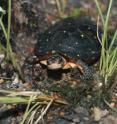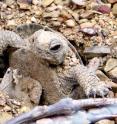Turtle populations affected by climate, habitat loss and overexploitation
Related images
(click to enlarge)
PORTLAND, Ore. February 1, 2011. Fact: The sex of some species of turtles is determined by the temperature of the nest: warm nests produce females, cooler nests, males. And although turtles have been on the planet for about 220 million years, scientists now report that almost half of the turtle species is threatened. Turtle scientists are working to understand how global warming may affect turtle reproduction. To bring attention to this and other issues affecting turtles, researchers and other supporters have designated 2011 as the Year of the Turtle. Why should we be concerned about the loss of turtles?
"Turtles are centrally nested in the food web and are symbols of our natural heritage. They hold a significant role in many cultures. For example, in many southeast Asian cultures turtles are used for food, pets, and medicine," explains Deanna Olson, a research ecologist and co-chair of the Partners in Amphibian and Reptile Conservation steering committee spearheading the Year of the Turtle campaign.
Turtles (which include tortoises) are central to the food web. Sea turtles graze on the sea grass found on the ocean floor, helping to keep it short and healthy. Healthy sea grass in turn is an important breeding ground for many species of fish, shellfish, and crustaceans. The same processes hold for freshwater and land turtles. For example, turtles contribute to the health of marshes and wetlands, being important prey for a suite of predators. The Year of the Turtle activities, include a monthly newsletter showcasing research and conservation efforts, education and citizen science projects, turtle-themed art, literature, and cultural perspectives, says Olson, a scientist with the Forest Service's Pacific Northwest Research Station.
Olson also co-authored a report, "State of the Turtle," and created a new turtle mapping project for the United States. The report is being translated into other languages for use here and around the world.
"A French translation of the report is already completed, and groups from Bangladesh and Germany signed on recently to help promote turtle conservation, and new partners join us each week," explains Olson.
Here are a few quick facts about turtles:
- About 50 percent of freshwater turtle species are threatened worldwide, more than any other animal group.
- About 20 percent of all turtle species worldwide are found in North America.
- Primary threats to turtles are habitat loss and exploitation.
- Climate change patterns, altered temperatures, affected wetlands and stream flow all are key factors that affect turtle habitats.
- Urban and suburban development causes turtles to be victims to fast-moving cars, farm machinery; turtles can also be unintentionally caught in fishing nets.
What can be done to conserve turtle populations?
- Protect rare turtle species and their habitats.
- Manage common turtle species and their habitats so they may remain common.
- Manage crisis situations such as acute hazards (i.e., oil spills) and rare species in peril.
Source: USDA Forest Service, Pacific Northwest Research Station
Articles on the same topic
- Mini or massive? For turtles and tortoises, it all depends on where you liveWed, 2 Feb 2011, 14:04:51 UTC
Other sources
- Turtle populations affected by climate, habitat loss and overexploitationfrom Science DailyWed, 2 Feb 2011, 17:33:35 UTC
- Turtle populations affected by climate, habitat loss and overexploitationfrom Science BlogWed, 2 Feb 2011, 15:01:30 UTC
- Turtle populations affected by climate, habitat loss and overexploitationfrom PhysorgWed, 2 Feb 2011, 14:30:37 UTC
- Mini or massive? For turtles and tortoises, it all depends on where you livefrom PhysorgWed, 2 Feb 2011, 12:00:14 UTC


